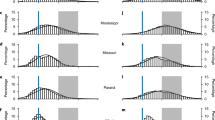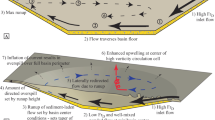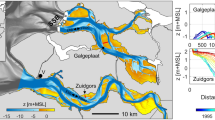Abstract
Migrating megaripples are bedforms that appear in the surf zone of sandy coasts1. With heights of 0.1–0.5 m and wavelengths of 1–5 m, they are similar in size and shape to small dunes, large ripples, or sand waves. Such sedimentary bedforms have been studied in subaerial2, steady-flow3 and intertidal4 environments, as well as in laboratory flume experiments5. They affect overlying currents by introducing hydraulic roughness4,6, and may provide a mechanism for sediment transport7,8 as well as forming sedimentary structures in preserved facies9,10. The formation, orientation and migration of such bedforms is not understood well11,12. Dunes, for example, can be aligned with their crests perpendicular to steady unidirectional winds13, but in more complex wind fields their orientation becomes difficult to predict14,15,16,17. Similarly, it is not known how sea-floor megaripples become aligned and migrate in the complex flows of the surf zone. Here we present observations in the surf zone of a natural beach which indicate that megaripples do not migrate in the direction of the vector sum of the currents, but are aligned so that the sediment transport normal to the bedform crest is maximized17. This may need to be taken into account in modelling morphology change and interpreting existing and fossil morphologic patterns.
This is a preview of subscription content, access via your institution
Access options
Subscribe to this journal
Receive 51 print issues and online access
$199.00 per year
only $3.90 per issue
Buy this article
- Purchase on Springer Link
- Instant access to full article PDF
Prices may be subject to local taxes which are calculated during checkout




Similar content being viewed by others
References
Clifton, H. E., Hunter, R. E. & Phillips, R. L. Depositional structures and processes in the non-barred high-energy nearshore. J. Sedim. Petrol. 41, 651–670 (1971).
Bagnold, R. A. The Physics of Wind Blown Sand and Desert Dunes (Methuen, London, (1954)).
Simons, D. B. & Richardson, E. V. Forms of bed roughness in alluvial channels. Am. Soc. Civ. Eng. Trans. 128, 284–302 (1963).
Dalrymple, R. W., Knight, R. J. & Lambiase, J. J. Bedforms and their hydraulic stability relationships in a tidal environment, Bay of Fundy, Canada. Nature 275, 100–104 (1978).
Southard, J. B., Lambie, J. M., Federico, D. C., Pile, H. T. & Weidman, C. R. Experiments on bed configurations in fine sands under bidirectional purely oscillatory flow, and the origin of hummocky cross-stratification. J. Sedim. Petrol. 60, 1–17 (1990).
Garcez Faria, A. F., Thornton, E. B., Stanton, T. P., Soares, C. V. & Lippmann, T. C. Vertical profiles of longshore currents and related bed shear stress and bottom roughness. J. Geophys. Res. 103, 3217–3232 (1998).
Allen, J. R. L. Current Ripples: Their Relation to Patterns of Water and Sediment Motion (North-Holland, Amsterdam, (1968)).
Middleton, G. V. & Southard, J. B. Mechanics of Sediment Movement. (Lecture for short course no. 3, Society of Economic Paleontologists and Mineralogists, (1982)).
Davidson-Arnott, R. G. D. & Greenwood, B. Facies relationships on a barred coast, Kouchibouguac Bay, New Brunswick, Canada. Beach and Nearshore Sedimentation, SEPM Special Pub. 24, 149–169 (1976).
Sherman, D. J. & Greenwood, B. Hummocky cross-stratification and post-vertex ripples: length scales and hydraulic analysis. Sedimentology 36, 981–986 (1989).
Werner, B. T. Eolian dunes: computer simulations and attractor interpretation. Geology 23, 1107–1110 (1995).
Stam, J. M. T. On the modelling of two-dimensional aeolian dunes. Sedimentology 44, 127–141 (1997).
Bagnold, R. A. Journeys in the Libyan Desert 1929 and 1939. Geogr. J. 78, 13–39 (1933).
Warren, A. Dune trend and the Ekman spiral. Nature 259, 653–654 (1976).
Tsoar, H. Dynamic processes operating on a longitudinal (seif) sand dune. Sedimentology 30, 567–578 (1983).
Hanna, S. R. The formation of longitudinal sand dunes by large helical eddies in the atmosphere. J.Appl. Meteorol. 8, 874–883 (1969).
Rubin, D. M. & Hunter, R. E. Bedform alignment in directionally varying flows. Science 237, 276–278 (1987).
Hay, A. E. & Wilson, D. J. Rotary sidescan images of nearshore bedform evolution during a storm. Mar. Geol. 119, 57–65 (1994).
Clifton, H. E. Wave-formed sedimentary structures-a conceptual model. Beach and Nearshore Sedimentation, SEPM Special Pub. 24, 126–148 (1976).
Moore, J. N., Fritz, W. J. & Futch, R. S. Occurrence of megaripples in a ridge and runnel system, Sapelo Island, Georgia: morphology and processes. J. Sedim. Petrol. 54, 615–625 (1984).
Sherman, D. J., Short, A. D. & Takeda, I. Sediment mixing depth and bedform migration in rip channels. J. Coastal Res. 15, 39–48 (1993).
Dalrymple, R. W. & Rhodes, R. N. Estuarine dunes and barforms. Dev. Sedimentol. 53, 359–422 (1995).
Hay, A. E. & Bowen, A. J. Alongshore migration of lunate megaripples during DUCK94. J. Geophys. Res. (in the press).
Gallagher, E. L., Boyd, W., Elgar, S., Guza, R. T. & Woodward, B. Performance of a sonar altimeter in the nearshore. Mar. Geol. 133, 241–248 (1996).
Bagnold, R. A. An approach to the sediment transport problem from general physics. US Geol. Surv. Prof. Paper 422-I(1966).
Rubin, D. M. Cross-bedding, bedforms, and paleocurrents: Concepts in sedimentology and paleontology. SEPM Special Pub. 1(1987).
Fryberger, S. G. Dune forms and wind regime. A Study of Global Sand Seas, Pap. US Geol. Surv. 1052, 137–170 (1979).
Rubin, D. M. & Ikeda, H. Flume experiments on the alignment of transverse, oblique, and longitudinal dunes in directionally varying flows. Sedimentology 37, 673–684 (1990).
Acknowledgements
We thank T. Drake for introducing us to ref. 17 and for sharing his insight into, and enthusiasm for, bedforms; R. T. Guza and B. T. Werner for suggestions and advice; D. Rubin for critically reading the manuscript; P. Fields for comments; and R. T. Guza, T. H. C. Herbers and B.Raubenheimer for help with acquiring field data. The instruments were fabricated, deployed and maintained by staff from the Center for Coastal Studies, Scripps Institution of Oceanography; the US Army Corps of Engineers Field Research Facility provided logistical support. Funding was from the Office of Naval Research, the NSF, and the National Research Council.
Author information
Authors and Affiliations
Rights and permissions
About this article
Cite this article
Gallagher, E., Elgar, S. & Thornton, E. Megaripple migration in a natural surf zone. Nature 394, 165–168 (1998). https://doi.org/10.1038/28139
Received:
Accepted:
Published:
Issue Date:
DOI: https://doi.org/10.1038/28139
This article is cited by
-
Early Cambrian wave-formed shoreline deposits: the Hardeberga Formation, Bornholm, Denmark
International Journal of Earth Sciences (2017)
-
Characterization of the Ophiomorpha rudis 3D boxwork in a turbiditic succession (Oligocene of the Alicante Province, southeastern Spain)
Journal of Iberian Geology (2017)
-
From biologically to hydrodynamically controlled carbonate production by tectonically induced paleogeographic rearrangement (Middle Miocene, Pannonian Basin)
Facies (2014)
-
Improving the time resolution of surfzone bathymetry using in situ altimeters
Ocean Dynamics (2014)
-
Observations of bedforms on a dissipative macrotidal beach
Ocean Dynamics (2014)
Comments
By submitting a comment you agree to abide by our Terms and Community Guidelines. If you find something abusive or that does not comply with our terms or guidelines please flag it as inappropriate.



